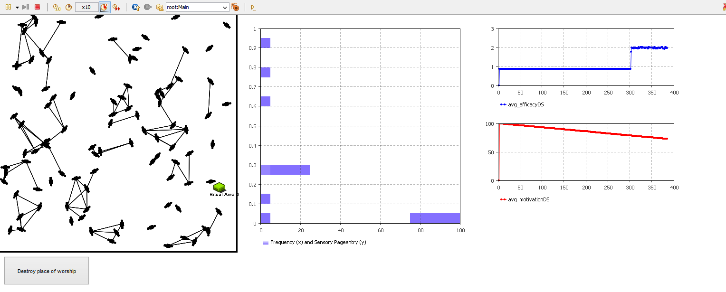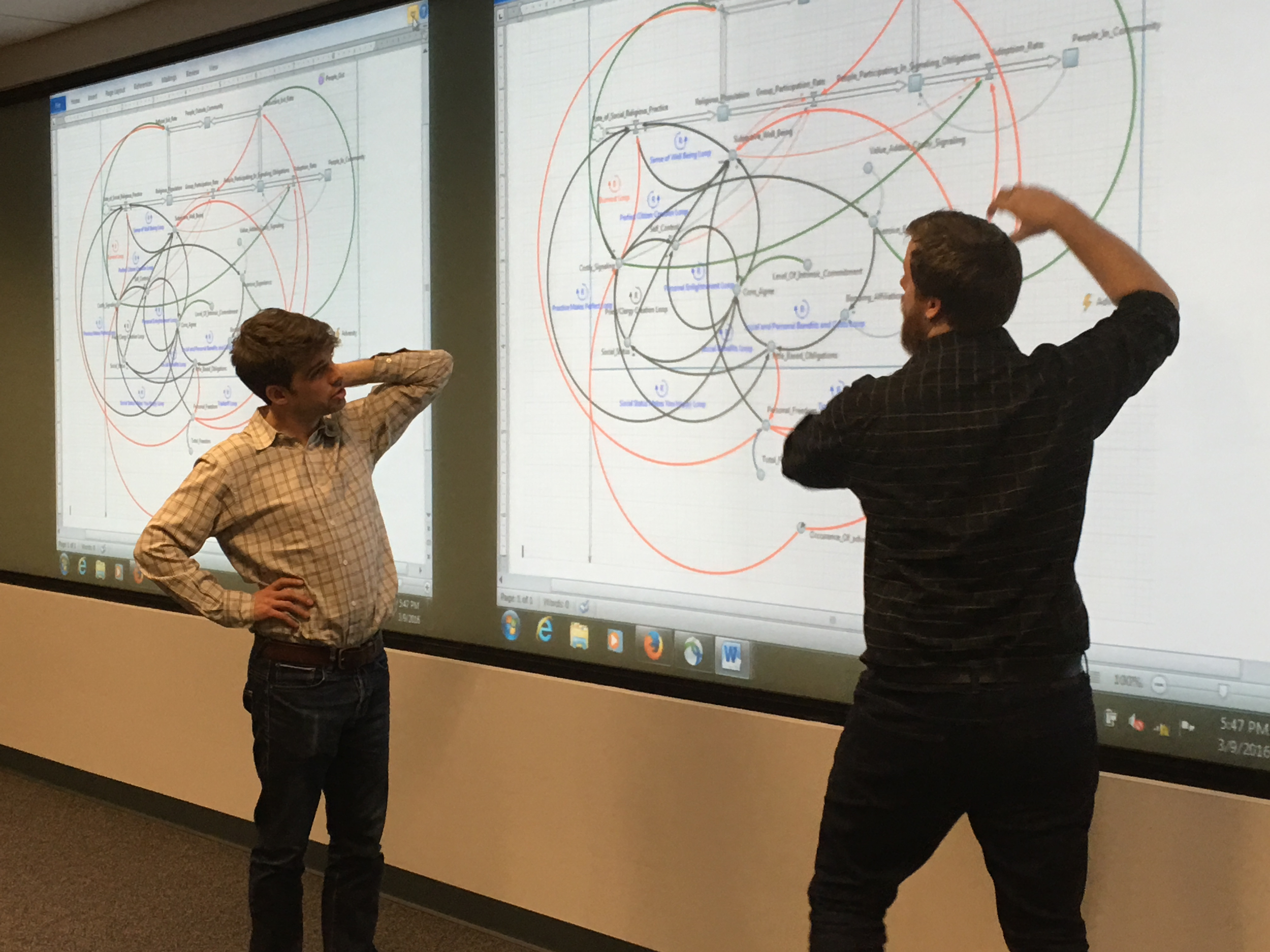For centuries, scholars and scientists have posed the question: what are the most compelling features of religion? Is it complex theological systems? Rituals that increase social solidarity? Fear of the afterlife or the unknown? In response to these questions academics from philosophers to evolutionary biologists who study religion have developed numerous theories to help explain religious beliefs and behaviors. But how do these approaches relate to one another? How could their relative merits and flaws be tested systematically?
Approach
At CMAC, we tackle these questions by turning to an unconventional source: computer modeling and simulation. By building agent-based and system-dynamics models of psychological and social processes, we are creating comparable versions of theories that can be rigorously tested against real-world data and the historical record.
This undertaking requires a wide variety of experts, including scholars of religion from the humanities, cognitive psychologists, and complex system specialists, as well as modelers and programmers. It has unfolded across three organizations (CMAC, the Virginia Modeling and Simulation Center, and the Center for Modeling Social Systems at the University of Agder in Norway), and brought together a large international and interdisciplinary team. Our work modeling religion has enabled our team to clarify and operationalize theories of religion, build realistic and complex AI systems and introduce the power and potential of simulation in the social sciences.
Impact
The MRP team has developed computer models to examine processes of group formation, religious leadership, extremism and violence, terror management, ritual patterns, and much more. These models have been published in a number of journals and led to several new projects, such as Modeling Religion in Norway. The MRP team has also presented in many different venues, notably leading panels on modeling religion for the past  two years at the American Academy of Religion conference, since 2016 at conferences for the International Association for the Cognitive Science of Religion, and even at computer simulation conferences.
two years at the American Academy of Religion conference, since 2016 at conferences for the International Association for the Cognitive Science of Religion, and even at computer simulation conferences.
MRP has also been working to produce a computer system with a user-friendly interface for developing simulations without needing to know any programming languages. This will empower scholars who have not been trained in computer science to actively participate in computer modeling. We call this web-based system METAPHR and plan on releasing it after a few more rounds of testing.
A selection of the models developed by our team:
-
- ERICA: a model of Robert McCauley and Thomas Lawson’s Ritual Competence theory
- NoRM: an agent-based model of security, education, and religion
- Agent_Xeno: A model of identity fusion and sacred values that simulates intergroup conflict
- Sex, Gender, and Shamanism: an agent-based model of gender dynamics and religious trance
- CRED and Charisma: A model testing the costly signaling theory of religious adherence
- MERV: A model of mutually escalating religious violence
- NAHUM: A model of the evolved hazard precaution system and terror management theory
MRP has been a powerful learning process for all involved, with humanities scholars learning how to theorize in a computational language and computer scientists gaining deeper insight into the complexity of human dynamics.
For more information about the MRP, the best place to start is the documentary series about the project created by our terrific documentarian Jenn Lindsay (click here).
Publications
Wood, C., Diallo, S., Gore, R., and Lynch, C.J. “Trance, Dissociation, and Shamanism: A Cross-Cultural Model.” To appear in special issue of Journal of Cognition and Culture. 2018.
Gore, Lemos, and Shults, “Forecasting Changes in Religiosity and Existential Security with an Agent-based Model,” Journal of the Artificial Social Simulation Society, 2018
Shults, Wildman, Gore, Lane, Lynch, and Diallo, “Modeling terror management theory: Computer simulations of the impact of mortality salience on religiosity,” Religion, Brain & Behavior, 2017.
Shults and Wildman, “Modeling Catalhoyuk: Simulating religious entanglement in a Neolithic town,” in Ian Hodder, ed., Religion, History and Place. Denver: University of Colorado Press, 2018.
Shults, Gore, Lemos, and Wildman, “Why do the godless prosper? Modeling the cognitive and coalitional mechanisms that promote atheism.” Psychology of Religion and Spirituality, in press.
Shults, “Can we predict and prevent religious radicalisation?” in Gwyneth Øverland, ed., Processes of Violent Extremism in the 21st century: International and Interdisciplinary Perspectives. Cambridge Scholars Press, in press.
Shults, “Simulating Supernatural Seeking,” commentary article in response to “Seeking the Supernatural” target article, Religion, Brain & Behavior, in press.
Shults, “How to survive the Anthropocene: Adaptive atheism and the evolution of Homo deiparensis,” Religions 6/2 (2015): 1-18.
Shults, “What’s the Use? Pragmatic Reflections on Neville’s Ultimates,” American Journal of Theology & Philosophy 36/1 (2015):
Shults, Theology After the Birth of God: Atheist Conceptions in Cognition and Culture, Palgrave Macmillan 2014.
Shults, “Theology after the Birth of God: A Response.” Syndicate: A New Forum for Theology 2/3 (2015): 91-109.
Shults, “Religion and the Prizing of Peace: Reflections on the 2014 Nobel Peace Prize,” 232-236 in Ernst Håkon Jahr, Rolf Tomas Nossum, and Leiv Storesletten, eds., Agder Vitenskapsakademi Årbok. Kristiansand: Portal, 2015.
Tolk, Wildman, Diallo, and Shults, “Human Simulation as Lingua Franca for relating the Humanities and Social Sciences,” to appear in a special issue of the Journal of Cognition and Culture, in production for 2018.
Wildman, Shults, and Fishwick, “Teaching at the intersection of simulation and the humanities,” with Wesley J. Wildman and Paul Fishwick, in Proceedings of the 2017 Winter Simulation Conference, in press.



